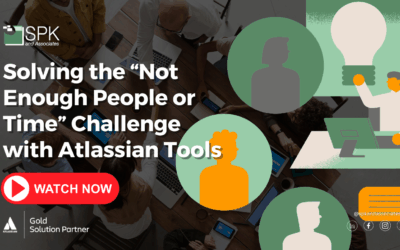Introduction
Hi everyone, I’m Michael Roberts, Vice President of Sales and Marketing here at SPK and Associates. Joining us today is an important person to our organization. We’re going to talk about diving into a really important Jira for enterprise use case scenario and how companies can maximize the ROI and ensure they’re using best practices during an enterprise-wide Jira adoption. To unpack this topic is my colleague, Carlos Almeida. Carlos, thanks for being here. Feel free to introduce yourself.
Thanks, Michael. I’m feeling important, thank you for that. I am the VP of Engineering and have been working with SPK for going on 15 years. It feels like just yesterday, but through that time, SPK and I have been working with numerous customers in the Atlassian ecosystem and other spaces such as DevOps and engineering best practices. We have a lot of war tales and best practices when it comes to large-scale, enterprise-wide adoption for Jira, and we’d love to share some of that with you today. We’re very lucky to have someone who’s led countless Jira implementations across different companies—small and large, Fortune 1000 and startups.
Addressing Key Challenges in Jira Adoption
Carlos, let me start by addressing the elephant in the room. There are a lot of large organizations that struggle with scaling Jira effectively. From your experience, what are some of the key challenges enterprises face when adopting Jira at scale, and how do they overcome them?
Overcoming Key Challenges
Thanks, Michael. This is sort of a soapbox for me. I believe it’s important to start with a game plan on day one. We’ve seen many of our customers tend to grow organically, often by acquisition, with no plan in place on how to scale up. When you have a larger organization using Jira or any of the Atlassian tools, it can get really messy and hard to administer.
I like to begin with governance. Governance is one of the biggest challenges. When everyone has admin access or can create their own projects or workflows, you end up with this “wild west” of custom fields and issue types, random statuses. It slows everything down and becomes a nightmare to manage.
Then there’s standardization. Different teams want to have their own flavors of Jira projects, which makes sense, but without consistency in workflows, naming conventions, etc., scaling up across the organization can become a total headache.
User adoption is another big one. People find Jira overwhelming or don’t see the value if they don’t know how to use it right. So if your Jira instance is not set up with end users in mind, and if there’s inadequate training or support, it becomes that tool we’re “supposed to use,” instead of something people want to use.
Finally, integration with other tools—whether it’s Confluence, GitLab, Slack, or maybe some marketplace app—without planning can lead to multiple, sometimes duplicate solutions. This not only makes things inefficient but can drive up your costs.
Our Approach to Addressing the Challenges of Jira Adoption
When we engage with a customer, we first start with defining your governance, defining your rules, getting your permissions, centralizing your admin team, and then we drive to create a core set of reusable workflows and templates. I am a big fan of company-managed projects where we can create a golden template for you, so you can focus your admin efforts. When new teams come on board, they can create from the template, and therefore you scale and grow in a repeatable, consistent way.
We’re also big advocates of training your admins. We want to make sure that we teach you to fish, as opposed to just being the fisherman. Therefore, we focus on making sure that your team has all the adequate training and really knows how to use the solution.
For integrations and apps, I always push for a formal functionality review via testing and prototyping. I come from the world of compliance and the regulated industry, so for me, it follows a formal process. I like to build a sandbox where we can demo, promote, and test, ensuring that the apps you have are the ones you really need to use and that you don’t have duplicates. We also make sure that the workflow between the different tools and the data flow is smooth, and we ensure the security between them is clean.
Atlassian Intelligence and Rovo
I like to do a formal review, testing, and prototyping before we push it into production. Another thing I’m currently advocating for is the planning of your AI component upfront. As you may know, Atlassian has made significant investments in AI solutions. The AI that comes out of the box with your Jira and Confluence instance is quite extensive. We can help you set up your knowledge base to leverage Atlassian intelligence, so you can now deflect tickets in your JSM or power up your agents for better self-help.
We could also help provide resources for your virtual agent to automatically respond 24/7. We can extend this with their newer offering, the Rovo solution, which I think is pretty amazing. It allows you to create virtual experts that are not just for IT. Additionally, it lets you extend your knowledge base. This is something our customers often need help with—maybe they have a knowledge base in a different place. With Rovo, I can now connect to your SharePoint or other existing knowledge bases, so you can pull all that information into your proprietary knowledge base.
All that’s a lot of information, and great points, Carlos. I have to say, we have personal experience with implementations in all of those areas, and how they went well because we organized those implementation components ahead of time. So, thank you for summarizing all that.
Maximizing ROI from Jira Features
So, another area of Jira that gets looked at a lot is the abundance of features inside of Jira, and even more now with all the Atlassian intelligence and Rovo features. But we know that not every company is getting all of the value out of those features. So, what are some best practices you would recommend for ensuring teams are getting the most ROI from their Jira investment?
Best Practices for Maximizing ROI
Yeah, Mike, that’s so true. There’s a ton of features, and there are even more coming out every day. So, the first thing is to stay on top of that with training and being aware of the company’s roadmaps. As an Atlassian partner, we’re right on the front line, making sure that what’s coming down the pipeline for our customers is in front of them so they can take advantage of it.
Automation
To get your money’s worth, you really need to understand how you can take advantage of the features you already have. Besides the roadmap, I’ll just highlight a few things I like to talk about. For me, automation is a big game-changer. Too many teams are still doing manual steps where they don’t need to be. If you can automate things like assigning tickets, updating statuses, or sending reminders, you’re not just saving time but also reducing human errors and speeding up the whole process.
I tell teams to start small with a few key automations and then build from there. And the best part is, many of those automations require no coding at all. I’m always surprised when I meet companies who aren’t taking advantage of this great automation platform that comes out of the box with little or no coding required. That’s one of the drums I like to beat on.
Reporting
Another key area is reporting. A lot of teams log their work in Jira but don’t really look at it. You can really expand that by taking advantage of dynamic dashboards, gadgets, and filters. When you set it up, you get real-time visibility into your bottlenecks, workload, and overall progress—whatever you need. There are also a ton of add-ons in the marketplace to check out for more reporting tools.
To me, it’s all about visibility—making sure that you’re tuning the system and aligning it to your business needs as best as possible.
Training
And again, I’ll mention training. Sometimes, your team may not have a full-time Jira admin on board, and the platform is rich with other tools, even within the individual tools themselves, which are growing with new capabilities and features. I believe it’s important to invest in training, whether it’s a refresher on what’s coming down the pike or learning something new. At SPK, we believe in teaching our customers to fish as admins, so they can maintain or extend their environment.
But we also recognize that sometimes you may not have the time—folks are really busy. So, we’re always ready to partner with you to help offload some or all of this. We engage with customers where we provide application management—not just quick fixes, but a red phone—anything you need, we’re there to help you. This is another great investment to help you get the ROI out of your Jira platform.
I love that, especially the part about the automations. It’s one of my favorite tools inside of Jira.
Driving Jira Adoption Across Departments
Okay, so Carlos, here’s the last big one: enterprise-wide Jira implementation often requires executive buy-in and cross-departmental collaboration and approvals. So, how can organizations drive adoption across all teams—from IT to HR, finance, and everyone else? How can they get adoption across all of those teams?
Yeah, that’s a big, important goal. A big yes for me. You really want to get Jira adopted across the entire organization, not just IT. It is totally doable, but it takes more than just flipping a switch. You have to think in terms of change management and ROI.
Driving Executive Buy-in
First up, I like to focus on executive buy-in. If your leadership sees Jira as just another IT tool, it’s going to stay stuck in that corner. But if you can somehow show how it supports transparency, accountability, and better decision-making in other areas as well, then you have something more interesting. Jira can be extended into so many departments beyond IT—finance, HR, sales, marketing, compliance, risk management, acquisition teams—you name it. Pretty much any group you can imagine. If you can sell that idea, then Jira becomes a true business tool, not just an IT tool.
This is where you need your executive buy-in. You also need to show them that at the grassroots level. That’s really important. If Jira is already on your approved app list, that’s a huge win. You can start encouraging your teams to experiment in low-risk ways. For example, we can set up a sandbox for you. Let’s pick your finance team and have them do some sprints on how to manage vendor payments. Or set up an HR team in a sandbox with your onboarding program. Show them how it’s done.
Conducting Demos
I’m a big believer in experimentation, prototyping, and demoing because that fires the imagination. It also gives you the ability to learn what you don’t know and where you can go with it, because every company is different.
At SPK, I come from a compliance-focused, regulated industry approach, but I also believe that we need to mix in an agile approach. From idea to rollout, we’ll build you a sandbox where we can create your custom project and prototype it. We can do a UAT (User Acceptance Testing) in there, get validation feedback, and then be able to demo through your organization back to your executive team.
The goal here is to build a backlog. Your system is not one and done. It’s going to constantly evolve as your business needs change. You need to have that backlog of new features and improvements. If we can help you build that mindset—where you have your backlog, a place to try things out, demo, and track ROI—then you can push it into production. Now you have a good pipeline of abilities to continually evolve your system and make improvements, ensuring you’re really aligning your Jira instance with your needs.
Conclusion
Thank you, Carlos, for those amazing insights. I really appreciate your time and experience in giving us that level set. For those of you watching, if your organization is trying to figure out how to scale Jira or maximize the ROI, please take those answers from Carlos to heart. They come with lots of years of experience and lessons learned.
Just trying to say I’m old—I get it. I didn’t say that! I didn’t say that.
And of course, if you’re looking for a strategic partner to help with your Jira rollout or implementation, you can contact us. SPK & Associates is a gold Atlassian solution partner, and this is the kind of stuff we do all the time. If you like this video, be sure to like and subscribe to our channel, especially if you want to see more content like this.
Until next time, Carlos, thank you, and thank you for joining. Appreciate it. Take care, everyone!







